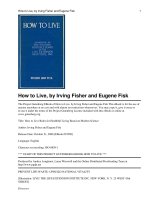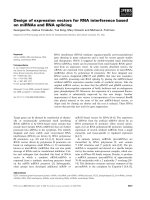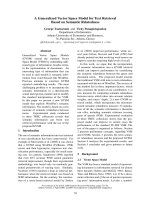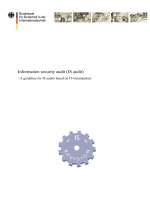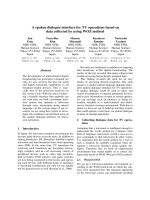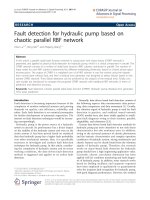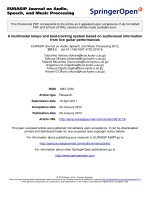Microbial biotransformation as a tool for drug development based on natural products from mevalonic acid pathway: A review
Bạn đang xem bản rút gọn của tài liệu. Xem và tải ngay bản đầy đủ của tài liệu tại đây (1.6 MB, 17 trang )
Journal of Advanced Research (2015) 6, 17–33
Cairo University
Journal of Advanced Research
REVIEW
Microbial biotransformation as a tool for drug
development based on natural products from
mevalonic acid pathway: A review
Mohamed-Elamir F. Hegazy a,b,*, Tarik A. Mohamed b,
Abdelsamed I. ElShamy c, Abou-El-Hamd H. Mohamed d,
Usama A. Mahalel e, Eman H. Reda b, Alaa M. Shaheen b, Wafaa A. Tawfik b,
Abdelaaty A. Shahat b,f, Khalid A. Shams b, Nahla S. Abdel-Azim b,
Fayza M. Hammouda b
a
Phytochemistry Department and Center of Excellence for Advanced Sciences, National Research Centre, El-Tahrir Street,
Dokki, Giza 12622, Egypt
b
Phytochemistry Department, National Research Centre, El-Tahrir Street, Dokki, Giza 12622, Egypt
c
Department of Natural Compounds Chemistry, National Research Centre, Dokki, 12311 Cairo, Egypt
d
Department of Chemistry, Aswan-Faculty of Science, South Valley University, Aswan, Egypt
e
Department of Botany, Aswan-Faculty of Science, South Valley University, Aswan, Egypt
f
Pharmacognosy Department, College of Pharmacy, King Saud University, Riyadh 11451, Saudi Arabia
A R T I C L E
I N F O
Article history:
Received 22 June 2014
Received in revised form 11
November 2014
Accepted 18 November 2014
Available online 22 November 2014
A B S T R A C T
Natural products are structurally and biologically interesting metabolites, but they have been
isolated in minute amounts. The syntheses of such natural products help in obtaining them in
bulk amounts. The recognition of microbial biotransformation as important manufacturing
tool has increased in chemical and pharmaceutical industries. In recent years, microbial
transformation is increasing significantly from limited interest into highly active area in green
chemistry including preparation of pharmaceutical products. This is the first review published
* Corresponding author. Tel.: +20 1022900036; fax: +20 233370931.
E-mail address: (M.F. Hegazy).
Peer review under responsibility of Cairo University.
Production and hosting by Elsevier
/>2090-1232 ª 2014 Production and hosting by Elsevier B.V. on behalf of Cairo University.
18
M.F. Hegazy et al.
Keywords:
Natural products
Biotransformation
Microbial biocatalysts
Pharmaceutical products
on the usage of microbial biocatalysts for some natural product classes and natural product
drugs.
ª 2014 Production and hosting by Elsevier B.V. on behalf of Cairo University.
Mohamed-Elamir F. Hegazy, Associate
Professor in Chemistry of Medicinal plant
Department, National Research Center, who
has two Ph.D. degrees: A Ph.D. degree from
Hiroshima University, Japan, and a Ph.D.
degree from Elminia University, Egypt. Dr.
Hegazy is working in the field of natural
products chemistry and biotransformation of
natural compounds with cultured plant cells
from ten years ago and he had a strong
experience in the isolation, purification and
identification of natural compounds form medicinal plants and marine
organisms using high technique for identification (1D and 2D NMR
analysis).
Tarik A. Mohamed, Researcher in National
Research Centre, Egypt. His research interest
focused on Chemical Constituents of Medicinal
Plants and Marine Organisms, Extraction,
Isolation and Purification of Natural Bioactive
Compounds, Structural Elucidation of Natural
Products by Modern Techniques of Spectroscopic Analysis, MS, HRMS, 1D and 2D NMR
and X-ray analysis, Biological Activities of
Natural Products against different common
diseases and Biotransformation for Natural
Compounds.
Abd El-Samid I. El-Shamy, Researcher in
National Research Centre, Egypt. His
research experiences are focused on isolation,
identification of phenanthrenes, flavonoids,
sterols, terpenes, coumarines, volatile oils,
ceramides from medicinal plants and marines
by different isolation and identification
methods. Synthesis of derivatives of natural
products. Bioactive assay in vivo and in vitro
of natural products such as hepatoprotective,
anticancer, antimicrobial and antiulcer.
Abou-El-Hamd H. Mohamed, Professor of
Natural products chemistry. He is a specialist
in natural products isolation and purification
of natural product compounds by using different technique (Column chromatography,
TLC, HPLC) Identification of naturally isolated pure compounds by using 1D and 2D
NMR analysis II – Biotransformation and
biocatalysis with Plant cell tissue culture;
Biotransformation of organic and natural
compounds; Enzyme purification Bioassay.
Usama A. Mahalel, Associate Professor of
plant taxonomy. His research interest, include
Medicinal plant and natural products
chemistry.
Eman H. Reda, a master student, has an
experience in isolation and purification of the
active constituents from medicinal plants
using modern techniques.
Alaa M. Shaheen, a master student, has an
experience in isolation and purification of the
active constituents from medicinal plants
using the modern techniques.
Wafaa A. Tawfik, Assoc. Prof. of Phytochemistry. She has experience in Phytochemical
screening of medicinal plants, isolation and
identification of the active constituents by using
the modern physiochemical techniques, isolating
colors and flavors from natural resources,
Extraction of oils from plants, interpretation of
spectral data with special emphasis to NMR
analysis.
Microbial biotransformation and drug development
Abdelaaty A. Shahat, Professor of Phytochemistry. He is a specialist in Phytochemical
evaluation of the Medicinal Plants as flavonoids, alkaloids, coumarine, terpens, proanthocyanidins, phenolic compounds, lignans,
organic acids, etc. Isolation and Identification
of the active constituents of the medicinal
plants using chromatographic techniques
{column, Thin Layer, and Paper chromatography, High Performance Liquid Chromatography (HPLC)}. Bioassay guided isolationpharmacological and biological evaluation of medicinal plant used in
tradition medicine. For example antiviral, antibacterial, antioxidant,
anticomplement modulation, anti-osteoporosis, anti-obesity, antianemia, etc.
Khalid A. Shams, Professor of Phytochemistry, he has experience in isolation and identification of the active constituents from
medicinal plants, by using the modern physiochemical techniques. He is familiar with
extraction techniques such as MicrowaveAssisted Extraction (MAE), UltrasonicAssisted Extraction (UAE), Accelerated Solvent Extraction (ASE) and supercritical fluid
extraction (SFE).
Nahla S. Abdel-Azim, Professor of Phytochemistry. She has experience in isolation and
purification of the active constituents from
medicinal plants by using the modern techniques, interpretation of spectral data with
special emphasis to NMR analysis, pharmacological screening of medicinal plants &
Extraction of medicinal plants using innovative, green and friendly environmental
extraction techniques such as MicrowaveAssisted Extraction (MAE), UltrasonicAssisted Extraction (UAE), Accelerated Solvent Extraction (ASE) and
supercritical fluid extraction (SFE).
Faiza M. Hammouda, Professor of Phytochemistry Awarded ‘‘State Recognition Prize
in the realm of Advanced Technological Sciences (Basic Sciences)’’ 2003.Co-author of 160
published research papers in national and
international journals. Supervised 55 Ph.D.
and 42 M. Sc. Thesis, Co-author in 10 books.
Principle Investigator of more than 20
national and international projects (FDA,
UNDP, GEF, IUCN). Member in Scientific
Ethics Council in AST.
Introduction
Natural product compounds are structurally and biologically
interesting metabolites. Compounds isolated are often available in minute amounts. Thus, synthesis of natural products
also provides a powerful means in solving supply problems
19
in clinical trials and marketing of the drug for obtaining
natural products in bulk amounts. If the structure is complex,
it is often an impossible task to isolate enough of the natural
products for clinical trials [1–3].
The recognition of biotransformation as important manufacturing tool has increased within chemical and pharmaceutical industries in recent years. Biocatalysts can simplify, or in
some instances even enable, the production process of complex
chemicals and drug intermediates. They can add stereospecificity to the process, eliminating the need for complicated separation and purification steps. The ability of biocatalysts to
selectively produce useful products under relatively mild conditions compared to its chemical catalyst counterpart make biocatalysts an interesting and powerful addition. Recent
advances in technology have markedly increased the ability
of industry to discover new biocatalysts and optimize their performance. These advances are coming at a time when both the
chemical and pharmaceutical industries are facing increasing
pressure to produce more effective natural products and to
make them more efficiently [2]. In this report, we discuss the
advances in technology for microbial transformation of natural product compounds.
Microbial transformation
Biocatalysis scope of study involving microbial transformation
is increasing significantly from limited interest into highly
active area in chemistry today including preparation of pharmaceutical products. Biotransformation can be clarified as
the specific modification of a definite compound to a distinct
product with structural similarity, by the use of biological catalysts including microorganisms like fungi [4]. The biological
catalyst can be described as an enzyme, or a whole, inactivated
microorganism that contains an enzyme or several enzymes
produced in it. Bioconversion is another term related to microbial transformation for this study in particular. There is only
slight difference between a biotransformation and a bioconversion. A bioconversion utilizes the catalytic activity of living
organisms and hence can involve several chemical reaction
steps. A living microorganism will be continuously producing
enzymes and hence bioconversions often involve enzymes
which are quite unstable for used substrates. The properties
of biotransformations and bioconversions are very similar
and in many cases the terms are cited as interchangeable [5].
On the other hand, fermentation, science under zymology
utilizes microorganisms, yeast was known to turn sugar into
alcohol since 1857 by the French chemist, Louis Pasteur.
The biotransformation processes have advantages overcome
some of the inherent problems and examples of some commercially successful processes [6]. To utilize from this processes,
biocatalysis research have been suggested for the nation’s rich
natural resources mainly with the endophytes available.
Biotransformation processes are far more diverse than therapeutic protein production processes [7]. There are many
microorganism strains and enzymes required to exploit the
selective biotransformation potential for the bioconversion of
a myriad of different substances into the desired products
especially new optically active main pharmaceutical ingredients. Timeline compressions in the development cycle of
pharmaceuticals, in combination with a missing broad strain
and enzyme choice, result in the fact that biotransformation
20
M.F. Hegazy et al.
typically represents the second generation process choice in the
manufacturing of a small molecule pharmaceutical. Novel
biocatalysts are needed first and foremost especially oxidoreductases and lyases for biotransformation.
Biotransformation is also known to comply with the green
chemistry strategy today. Green chemistry is a term used for
sustainable chemical industrial manufacturing processes
toward achieving minimal waste production and energy
consumption [8]. Thus, biosynthesis and biotransformation
are assumed to play a key role in green chemistry in the years
to come.
Advantages of microbial transformation
Many benefits can be obtained through microbial transformations studies. The process required in microbial transformation
may most probably have the ability to operate at near neutral
pH, ambient temperatures and atmospheric pressures [6]. In
contrast, chemistry often requires extremes of these conditions
which are not exactly environmentally friendly and industrially
undesired. Furthermore, extreme pH, temperature and pressure may provide harmful effects toward personnel operating
the harsh procedures and may also affect community surrounding the areas.
More importantly biocatalysts are highly reaction specific,
enantiomer-specific and regio-specific [6]. This is mainly and
directly referring to the chemical structure of a compound
one may want to obtain specifically. Many versatile microorganisms can be utilized to carry out extremely specific conversions using substrates of low cost [9].
The basic chemistry reactions include addition reactions,
elimination reactions, substitution reactions, pericyclic
reactions, rearrangement reactions and redox reactions. The
steps may be lengthy and more tedious at times as chemical
substances are easily disturbed by the humid environment in
tropical areas for instance. Humid tropical climates over here
are recorded by hot, wet climates, with average temperatures
of 18 °C or higher and an average rainfall of 203 cm or more.
Microorganisms have great potential for inducing many
alternatives of innovative and improvised enzyme systems
which are capable for converting unfamiliar substrates. Therefore, many studies can be performed to a greater extend
regarding different endophyte species toward chemical alterations of molecules and compounds of interest. The genome
of a novel thermophilic fungal species can be assessed to provide with gene sequences that encode for thermotolerant
enzymes, which are more stable to variations of reaction
temperature.
Not as the name may suggest physically, microbes are creature incredibly small for the naked eyes to see but carry major
roles today in pharmaceutical industry one way or another.
Microorganisms are capable of producing unique enzymes
which are stable toward heat, alkali and acids. One of the studies done was regarding hyperthermophilic archaeon Pyrobaculum calidifontis VA1 which produced a thermostable esterase
[10,11].
Their small size has by far the largest surface-to-volume
ratio in comparison with some living organisms. Thus, this
allows them to maximize their metabolic rates because of a
high exchange of molecules and metabolites through their surface. With the right cultivation conditions, microorganisms
grow exponentially [7].
Microorganisms are capable to produce great variety of
enzymes in a short period of time as a result of its natural characteristic to multiply. It is also possible to obtain and cultivate
microorganisms that can survive under extreme environments
such as low or high temperatures and/or acidic or alkali conditions. Microbial transformation can make feasible reactions
that are not likely to be carried out by traditional synthetic
procedures. Also, endophytes may produce natural, biodegradable compounds.
OH
OH
G. cingulata
HO
1
2
HO
G. cingulata
OH
OH
3
Fig. 1
4
Microbial transformations by Glomerella cingulata of two saturated acyclic monoterpenoids.
O
OH
O
OH
A.glauca
OH
5
6
7
8
Fig. 2 The biotransformation of (À)-carvone (5) and its metabolism to the diol 10-hydroxy-(+)-neodihydrocarveol (8) via (+)-transdihydrocarvone (6) and (+)-neodihydrocarveol (7) in 4 days.
Microbial biotransformation and drug development
21
Disadvantages and challenges of microbial transformation
(a)
Overcoming the existence of well-developed Organic Syntheses
technology however is an inherent challenge to biotransformation processes to grow and be frequently applied. Often there is
no financial incentive for implementing a new process when
old technology is known and investment in plants have been
paid for [12].
Technology used to enhance biotransformation and bioconversion processes may include immobilization techniques,
genetic engineering and the use of enzymes that cope with
organic solvents [6]. Examples of enzyme engineering are protein engineering and crosslinked enzyme crystals. Expertise
and equipments along with updated knowledge that is evolving
and increasing in the process of microbial transformation are
handy if acquired for useful novel compounds to be obtained.
The use of biocatalysts to carry out biotransformed products is often difficult as it involves the challenges of reactant
or product toxicity or inhibition, high dilution and the use of
pH and temperature labile biocatalysts. However, biological
and process solutions do exist to solve some of these problems
and methods to compare strategies and techniques for
biotransformation operation are being developed [4,13].
Besides that, if the substrate used is toxic, it can kill the
microorganism hindering any biotransformation to occur.
On the other hand, if the microorganism uses the substrate
as an energy source, none of the product desired is likely to
be recovered. Time restriction and missing broad strain or
enzyme choice cause biotransformation typically represents
the second generation process choice in the manufacturing of
a small molecule pharmaceutical [7].
Due to involvement of complex biological systems, very low
chemical yields are obtained. Enzymes are very specific and
therefore the chances of getting high probability of transformation is normally less and slow compared to chemical
transformation. Improvement is highly encouraged for the efficiency of microbial transformation to perform incomparably
or better industrially in a large scale with greater potential.
(b)
Microbial transformation of terpene compounds
Monoterpenes
The microbial transformations by Glomerella cingulata of two
saturated acyclic monoterpenoids, tetrahydrogeraniol (1) and
tetrahydrolavandulol (3), were investigated by Nankai et al.
[14]. Both compounds were hydroxylated regioselectively at
the isopropyl group. Tetrahydrogeraniol was transformed to
hydroxycitronellol (2), while tetrahydrolavandulol was transformed to 5-hydroxytetrahydrolavandulol (4) (Fig. 1) [14].
The cyclic monoterpene ketone (À)-carvone (5) was
metabolized by the plant pathogenic fungus Absidia glauca.
After 4 days of incubation, the diol 10-hydroxy-(+)-neodihydrocarveol (8) was formed via (+)-trans-dihydrocarvone (6)
and (+)-neodihydrocarveol (7) in 4 days (Fig. 2) [15].
Sesquiterpenes
Fig. 3
Microbial transformation of sesquiterpe phenols.
Microbial and chemical transformation studies of the
marine sesquiterpene phenols (S)-(+)-curcuphenol (9) and
22
M.F. Hegazy et al.
Fig. 4
Cunninghamella echinulata and Rhizopus oryzae transformation of sesquiterpene lactones.
Microbial biotransformation and drug development
23
OH
O
O
HOOC
O
HOOC
O
HO
43
44
46
HOOC
O
O
HOOC
O
HO
OH
47
Fig. 5
O
OH
OH
OH
HOOC
45
48
O
H3COOC
49
50
Transformation of (+)-(S)-ar-turmerone (43) and (+)-(S)-dihydro-ar-turmerone (44) by the fungus Aspergillus niger.
OH
OH
HO
OH
HO
OH
OH
O
51
53
OH
OH
OH
OH
HO
52
HO
HO
OH
HO
HO
OH
OH
OH
O
54
55
56
Fig. 6 Transformation of 13R,14R,15-trihydroxylabd-7-ene (54) and 13R,14R,15-trihydroxylabd-8(17)-ene (55) by the fungus
Debaryomyces hansenii.
(S)-(+)-curcudiol (18), isolated from the Jamaican sponge
Didiscus oxeata, were accomplished. Preparative-scale fermentation of sesquiterpenoid 9 with Kluyveromyces marxianus var.
lactis (ATCC 2628) has resulted in the isolation of six new
metabolites: (S)-(+)-15-hydroxycurcuphenol (10), (S)-(+)12-hydroxycurcuphenol (11), (S)-(+)-12,15-dihydroxycurcuphenol (12), (S)-(+)-15-hydroxycurcuphenol-12-al (13),
(S)-(+)-12-carboxy-10,11-dihydrocurcuphenol
(19),
and
(S)-(+)-12-hydroxy-10,11-dihydrocurcuphenol (20). Fourteen-days incubation of 9 with Aspergillus alliaceus (NRRL
315) afforded the new compounds (S)-(+)-10b-hydroxycurcudiol (21), (S)-(+)-curcudiol-10-one (22), and (S)-(+)-4-[1-(2hydroxy-4-methyl)phenyl)]pentanoicacid (25). Rhizopus arrhizus (ATCC 11145) and Rhodotorula glutinus (ATCC 15125)
afforded (S)-curcuphenol-1(R)-D-glucopyranoside (14) and
(S)-curcudiol-1(R)-D-glucopyranoside (23) when incubated
for 6 and 8 days with 9 and 18, respectively.
Reaction of 9 with NaNO2 and HCl afforded (S)-(+)-4nitrocurcuphenol (15) and (S)-(+)-2-nitrocurcuphenol (16) in
a 2:1 ratio. Acylation of 9 and 18 with isonicotinoyl chloride
afforded the expected esters (S)-(+)-curcuphenol-1-O-isonicotinate (17) and (S)-(+)-curcudiol-1-O-isonicotinate (24),
respectively (Fig. 3A and B) [16].
Incubations of the fungi Cunninghamella echinulata and
Rhizopus oryzae with the sesquiterpene lactones (+)-costunolide (26), (+)-cnicin (27), (+)-salonitenolide (28), (À)-dehydrocostuslactone (30), (À)-lychnopholide (38), and (À)eremantholide C (41) were performed. Incubation of 26 with
24
M.F. Hegazy et al.
(a)
H
H
HO
RO
OH
H
OH
H
59 R = H
60 R = Ac
OR
OH
58
H
OH
H
57
OH
RO
H
OH
H
H
OH
OR
H
OH
61
62 R = H
63 R = Ac
OR
HO
O
O
H
OH
H
OR
H
64
OH
OR1
H
65
66
67
68
OR2
R = R = R =H
1
2
R = R = H,R =Ac
1
2
R = R = H,R = Ac
1
2
R = R = R = Ac
1
2
(b)
H
H
OR
H
RO
RO
OH
H
70 R = H
71 R = Ac
OR
OR
H
OR
H
RO
O
72 R = H
73 R = Ac
RO
O
O
78 R = H
79 R = Ac
H
OR
OR
OH
H
69
OH
RO
H
H
RO
OR
H
OH
OR
H
O
OH
H
74 R = H
75 R = Ac
O
76 R = H
77 R = Ac
80
OH
RO
RO
OR
OR
OR
HO
O
O
H
H+
OH
H
OH
OR
H
OR
H
OR
81
82 R = H
83 R = Ac
CHO
OH
OH
H
H
H+
OH
OH
80
84
CHO
H
85
OH
Fig. 7
Transformation of candidiol (15a,18-dihydroxy-ent-kaur-16-ene) by Mucor plumbeus.
Microbial biotransformation and drug development
25
OH
OH
HOOC
HOOC
HOOC
88
28 oC / 10days
Trichoderma sp.JY-1
HOOC
HOOC
OH
86
OH
HOOC
Fig. 8
87
Novel metabolites isolated from cultures of Trichoderma sp. JY-1 grown in the presence of nigranoic acid.
C. echinulata afforded D 11(13)-dihydrogenation and D1(10)epoxidation products (29, 33–35). C. echinulata also
hydrolyzed the side chain of 27, and transformed 30 into
(+)-11R,13-dihydrodehydrocostuslactone (31), a new natural
product. R. oryzae converted 30 into both D11(13)-dihydrogenation and D10(14)-epoxidation products (32 and 37). Both
fungi transformed 38 into (À)-16-(1-methyl-1-propenyl)eremantholanolide (42), providing experimental evidence for the
biosynthesis of the eremantholide hemiketal unit. Formation
of 33–35 can be explained by enzymatic epoxidation of 26 to
1b,10a-epoxicostunolide (36), and subsequent electrophilic
opening of the epoxide with concomitant rearrangement to
the eudesmanolide skeleton, as presumably occurs in plant
biogenesis of 1b-hydroxyeudesmanolides. Reaction of 38 with
Sodium borohydride (NaBH4) gave the alcohol product 40,
and treatment with Bu3–SnH only causes isomerization of
the lateral chain, leading to 39. Compounds 28 and 41 were
not metabolized by either fungus under the test conditions
(Fig. 4) [17].
Biotransformation studies conducted on (+)-(S)-ar-turmerone (43) and (+)-(S)-dihydro-ar-turmerone (44) by the fungus Aspergillus niger have revealed that 43 was metabolized to
give four oxidized metabolites, (+)-(7S)-hydroxydehydroar-todomatuic acid (45), (+)-(7S,10E)-12-hydroxydehydroar-todomatuic acid (46), (+)-(7S,10E)-7,12-dihydroxydehydroar-todomatuic acid (47), and (+)-(7S)-15-carboxy-9,
13-epoxy-7-hydroxy-9,13-dehydro-ar-curcumene (48), and
(+)-(S)-dihydro-ar-turmerone (44) was metabolized to (+)7,11-dihydroxy-ar-todomatuic acid (49) (Fig. 5) [18]. The
absolute configurations of 45 at the C-7 position were
established to be S after conversion into tetrahydro-2-(4-carbomethoxyphenyl)-2,6,6-trimethyl-4H-pyran-4-one (50).
fungus Debaryomyces hansenii gave 13R,14R,15-trihydroxy-6oxolabd-8-ene (51) and 7a,13R,14R,15-tetrahydroxy-labd8(17)-ene (53), respectively. While, microbial transformation
of 54 by A. niger afforded 3b,13R,14R,15-tetrahydroxy-labd7-ene (52), and 13R,14R,15-trihydroxylabd-8,17-ene (56) gave
53 and 3R,14R,15-3-oxotetrahydroxy-labd-7-ene (54) (Fig. 6)
[19].
The microbiological transformation of candidiol (15a,18dihydroxy-ent-kaur-16-ene, 57) by Mucor plumbeus led to
3b,15a,18-trihydroxy-ent-kaur-16-ene, 6a,15a,18-trihydroxyent-kaur-16-ene (61), 3b,15a,18-trihydroxy-entkaur-16-ene
(58), 3a,15a,18-trihydroxy-entkaur-16-ene (59), 11b,15a,18-trihydroxy-ent-kaur-16-ene (62) and 15a,17,18-trihydroxy11b,16b-epoxy-ent-kaurane (83), while the incubation of
15a,19-dihydroxy-ent-kaur-16-ene (69) gave 9b,15a,19-trihydroxy-ent-kaur-16-ene (80), 3a,15a,19-trihydroxy-ent-kaur-16ene
(70),
11b,15a,19-trihydroxy-ent-kaur-16-ene
(74),
6a,15a,19-trihydroxy-ent-kaur-16-ene (61), 15a,17,19-trihydroxy-11b,16b-epoxy-ent-kaurane (82), 19-(b-D-glucopyranosyl)-15a-hydroxy-ent-kaur-16-ene
(76)
and
19-(b-Dglucopyranosyl)-15-oxo-ent-kaur-16-ene (78). An interesting
rearrangement in dilute acid medium of 9b,15a,19-trihydroxy-ent-kaur-16-ene (80) into 16-oxo-19-hydroxy-ent-abiet
8(9),15-diene (84). The possible mechanism of formation of
this 8,15-seco-entkaurene diterpene is shown in Fig. 7b, a compound of this type, named hebeiabinin A (85) (Fig. 7A and B)
[20]. The following compounds 60, 63, 66–68, 71, 73, 75, 77,
79, and 81, were acetylated products to decrease polarity of
its original compounds. Compound 65 suggested to be an
artifact formed during the isolation procedure from the true
biotransformed metabolite 64.
Triterpenes
Diterpenes
Microbial transformation of 13R,14R,15-trihydroxylabd-7-ene
(54) and 13R,14R,15-trihydroxylabd-8(17)-ene (55) by the
Two new metabolites, 15a,16a-dihydroxy-3,4-secocycloarta-4
(28), 17 (20), 17 (E), 24 (E)-triene-3,26-dioic acid (87) and
16a, 20a-dihydroxy-18 (13 fi 17b) abeo-3,4-secocycloarta-4
26
M.F. Hegazy et al.
COOH
Streptomyces griseus
ATCC
COOH
+
COOH
O
COOH
O
HOH 2 C
90
91
COOH
O
O
89
O
Aspergillus ochraceus
O
CICC 40330
92
COOH
Streptomyces griseus
ATCC
COOH
+
COOH
HO
HO
HOH
94
COOH
95
2C
COOH
HO
O
93
O
Aspergillus ochraceus
CICC 40330
HO
96
HOOC
HOOC
Aspergillus ochraceus
CICC 40330
COOH
HO
COOH
HO
Streptomyces griseus
ATCC
O
CH OH
2
Xyl
O
CH OH
Xyl
2
us
98
rise
ces g
tomy C
C
AT
97
Glc
Strep
HOOC
HOOC
O
HO
COOH
HO
Aspergillus ochraceus
CICC 40330
HO
re
2
100
St
CH OH
CH OH
2
99
HO
O
s
eu
is
gr
es
yc C
om TC
pt A
HOOC
COOH
HO
HO
CH OH
101
2
Fig. 9
Microbial transformation of 4 olean-type pentacyclic triterpenes (OPTs).
Glc
Microbial biotransformation and drug development
27
25
O
22
12
O
103 0. 43%
15
H
HO
OH
OH
O
O
H
104 0. 36%
HO
OH
25
O
OH
22
O
O
H
22
OH OH
HO
12
105 0. 33%
15
25
O
O
O
15
106 0. 83%
C.Versicolor
OH
7
HO
H
HO
102
OH
OH
O
OH
O
107 0. 1%
H
HO
OH
OH
O
OH
O
108 0. 5%
H
HO
OH
OH
O
HO
O
109 0. 27%
H
HO
Fig. 10
OH
Microbialtransformation of diosgenin (3b-hydroxy-5-spirostene) (102) using white-rot fungus Coriolus versicolor.
(28), 12 (13), 24 (Z)-triene-3,26-dioic acid (88) were isolated
and identified from the co-cultures of nigranoic acid (86) and
Trichoderma sp. JY-1. Compound 87 was found to possess
an unusual 17(20), 17 (E)-ene structure and compound 88 featured an unprecedented 18(13 fi 17b)-abeo-secocyloarta skeleton (Fig. 8) [21].
Microbial transformation of 4-olean-type pentacyclic triterpenes (OPTs), 3-oxo oleanolic acid (89), oleanolic acid (93),
and esculentoside A (97) was studied. After the screening of
12 strains of microbes, preparative biotransformation by two
strains of Streptomyces griseus ATCC 13273 and Aspergillus
ochraceus CICC 40330 resulted in the isolation of 10 metabolites (90–92, 94–101). The microbial catalyzed high efficient
regio-selective methyl oxidation and glycosylation were discovered, which could be provided as an alternative method to
expand the structural diversity of OPTs (Fig. 9) [22].
Steroids
Microbial transformation of diosgenin (3b-hydroxy-5-spirostene) (102) using white-rot fungus Coriolus versicolor afforded
four previously unreported polyhydroxylated steroids, 25(R)-
28
M.F. Hegazy et al.
H
O
O
O
H
HO
O
H
H
OH
O
O
O
Artemisinin
O
H
O
O
H
110
O
O
O
9 α-Hydroxy artemisinin
O
3α-Hydroxy-deoxyratemisinin
111
H
O
O
O
O
O
H
O
O
H
O
O
O
9 β-Hydroxy-artemisinin
O
Artemisitone-9
112
Fig. 11
Fig. 12
114
H
OH
113
Biotransformation of Artemisinin.
Biotransformation of Paclitaxel and its analogues.
Microbial biotransformation and drug development
29
OH
OH
HO
OH
OH
121
OH
OH
OH
OH
OH
OH
OH
HO
HO
OH
OH
122
HO
119
123
OH
OH
HO
O
OH
O
OH
O
O
H
OH
HO
125
120
HO
OH
HO
OH
124
OH
OH
O
OH
HO
O
H
OH
O
OH
HO
OH
OH
126
OH
HO
O
OH
HO
128
HO
OH
Fig. 13
HO
OH
129
127
A proposed biotransformation pathway of 20(S)-protopanaxatriol by M. spinosus As 3.3450.
spirost-5-en-3b,7a,15a,21-tetraol
(106),
25(R)-spirost-5en-3b,7b,12b,21-tetrol (107), (25R)-spirost-5-en-3b,7a,12b,21tetraol (108), and (25R)-spirost-5-en-3b,7b,11a,21-tetraol
(109), along with three known congeners, 25(R)-spirost-5en-3b,7b-diol (103), 25(R)-spirost-5-en-3b,7b,21-triol (104),
and 25(R)-spirost-5-en-3b,7b,12b-triol (105) (Fig. 10) [23].
Microbial transformation of bioactive natural products
Biotransformation of artemisinin
Artemisinin, a sesquiterpene lactone has an endoperoxide
bridge, which was isolated from the Chinese herbal plant, Artemisia annua L. in 1972 [24]. Because of its high therapeutic values in treating malaria, tremendous efforts have been made
toward structure modification and analogue synthesis with
the aim of developing more potent antimalarial agents with
in vivo stability since it was discovered. The structural modifications usually took place at the lactone moiety of artemisinin
(110) due mainly to the difficulty of introducing functionalities
on the ring systems by conventional chemical methods. Transformation of artemisinin (110) with S. griseus ATCC13273,
affording artemisitone-9 (113), 9a-hydroxy-artemisinin, 9bhydroxy-artemisinin and 3a-hydroxy-deoxyartemisinin (111)
[25] (Fig. 11). Metabolites of 9a-hydroxy-artemisinin (114)
and 9b-hydroxy-artemisinin (112) were further oxidized to give
artemisitone-9 (113). A pathway for the production of
artemisitone-9 from artemisinin by S. griseus ATCC 13273
was proposed as well. In the case of using fungi for biotransformation, artemisinin was converted 10b-hydroxy-artemisinin
and 3a-hydroxy-deoxyartemisinin by C. echinulata AS 3.3400
30
M.F. Hegazy et al.
and A. niger AS 3.795 [26], as well as biotransformation
products of artemisinin by Penicillium chrysogenum ATCC
9480 [27]. The product 10b-hydroxy-artemisinin was obtained
in 67% yield when artemisinin was treated with ferrous sulfate
in acetonitrile/water [28]. Furthermore, other oxidative and
analogues at different positions products of artemisinin have
been reported as well. These include deoxyartemisinin,
3a-hydroxy-artemisinin, 10 hydroxy-artemisinin and 9bhydroxy-11a-artemisinin [27–30].
Biotransformation of Taxol and its analogues
Paclitaxel (TaxolÒ), first isolated from the bark of Taxus
brevifolia, is one of the most effective anticancer agents from
natural sources. It has been widely used for the treatment of
ovarian, breast and lung cancers. In order to reduce side effects
and increasing oral bioavailability, more than 500 microorganisms were screened for their ability to achieve useful biotransformation of taxol derivative (cephalomannine) (115). Taxol/
cephalomannine (115) was biotransformated by Streptomyces
sp. MA 7065, yielding 10-hydroxyacetyl-10-deacetyltaxol
(116), 30 -(4-hydroxyphenyl)-30 -dephenyltaxol (117) and 400 Hydroxycephalomannine (118) [31] (Fig. 12).
Biotransformation of panaxosides (ginsenosides)
Panaxosides or ginsenosides are the main effective constituents
isolated from the traditional Chinese herb ginseng, the roots of
Panax ginseng C.A. Meyer. It has been found that the intestinal bacterial metabolites of ginsenosides are responsible for the
major pharmacological activities of ginseng roots [32,33].
Investigation on antitumor activities of 20(S)-protopanaxatriol
showed that it did not directly inhibit tumor growth in vivo,
but that it stimulated splenic NK cells to become cytotoxic
to tumor cells [34]. There have been a number of reports on
the biotransformation of ginsenosides (119). The ginsenosides
20(S)-Protopanaxatriol (119) was transformed by a fungus
Mucor spinosus AS 3.3450, yielding various novel compounds
including 12-oxo-15a-hydroxyl-20(S)-protopanaxatriol (128),
27-hydroxyl-20(S)-protopanaxatriol (123), 12-oxo-26-hydroxyl-20(S)-protopanaxatriol (129), 12-oxo-27-hydroxyl-20(S)protopanaxatriol (125), 12-oxo-23b-hydroxyl-20(S)-protopanaxatriol (126), 20S,24R-epoxy-dammaran-3b,6a,25-triol12-one (124), 29-hydroxyl-20(S)-protopanaxatriol (121), 12oxo-11b-hydroxyl-20(S)-protopanaxatriol (127), 28-hydroxyl20(S)-protopanaxatriol (122) and 12-oxo-20(S)-protopanaxatriol (120) (Fig. 13). MTT assay indicated that eight metabolites
had more potent inhibitory effects against HL-60 cell line than
the parent compound [35,36]. Transformation of ginsenoside
Rg3 by Myrothecium verrucaria furnished the rare ginsenoside
Rh2 [37], a more potential molecule than ginsenoside Rg3.
Ginsenoside Rh2 can also prepared by enzymatic hydrolysis
of ginsenoside Rg3 using b-glucosidase or cell-free extract of
Fusarium proliferatum ECU2042 [38,39]. Ginsenoside Rh1
was obtained through transforming ginsenoside Rg1 by
A. niger AS 3.1858 or Absidia coerulea AS 3.3538 [40]. A
gypenoside-a-(1fi6)-L-rhamnosidase isolate from Absidia
sp.90 can hydrolyze the b-(1fi6)-L-rhamnoside at C-20 position of gypenoside-5 into ginsenoside Rd [41]. A novel b-glucosidase (G-II) from Cladosporium fulvum was also reported.
This glucosidase could specifically cleave the b-D-glucosidic
linkage at the C-20 position of ginsenoside Rb1 to produce
ginsenoside Rd, and did not hydrolyze the other b-D-glucosidic linkages in protopanaxadiol-type ginsenosides [42].
Pythium irregular was used to convert 20(S)-protopanaxadiol
ginsenosides such as Rb1, Rb2, Rc, Rd and gypenoside XVII.
Nearly all of the 20(S)-protopanaxadiol ginsenosides were
metabolized into the minor ginsenoside F2 [43]. Notably,
Rb1, the major ginsenoside, was converted to 20(S)-ginsenoside Rg3 by Microbacterium sp. GS514 [44].
Biotransformation of opiate alkaloid
The biotransformation of alkaloids by microbes and plants
was recently reviewed by Rathbone et al. [45,46], in which they
provide a summary of the progress of alkaloid biotransformations from mid-1980s to 2002. It is difficult to modify structures of alkaloids because of the complex polycyclic nature
HO
N
N
H
O
N
H3 C
N
N
131
O
Penicilliumjanthinellum AS3.510
+
H
H3C
N
130
HO
N
N
H
N
H 3C
132
Fig. 14
Biotransformation of evodiamine by Penicillium janthinellum AS 3.510.
O
Microbial biotransformation and drug development
Fig. 15
31
Biotransformation pathways of resibufogenin and cinobufagin by Pseudomonas aeruginosa.
of these compounds. Biotransformation offers a versatile tool
for structural modification of alkaloids in addition to known
chemical methods. Evodiamine is one of the major active alkaloids in Evodia rutaecarpa, a traditional chinese medicine,
which has been widely used in China for over two thousand
years. Biotransformation of evodiamine (130) by Penicillium
janthinellum AS 3.510 resulted in two metabolites, 10-hydroxyevodiamine (131) and 11-hydroxyevodiamine (132) [47–49]
(Fig. 14). The microorganisms and rats used similar metabolic
pathway for evodiamine. Many fungi have shown to possess
enzymes of catalyzing N- and O-demethylation of alkaloids.
For example, Mucor piriformis selectively N-demethylated
thebaine [48], and Streptomyces and C. echinulata strains
N-demethylated a indole alkaloid lergotrile [50], while various
Cunninghamella and Fusarium strains N-demethylated codeine
[51].
Moreover, biotransformation of a thebaine derivative using
the filamentous fungus C. echinulata NRRL1384 was reported.
The thebaine analog was converted to a mixture of
N-demethylated and N,O-demethylated products [52].
Biotransformation of bufalin
The biotransformation of steroid compounds by microbes was
reviewed by Fernandes in 2003 [53], but considerable progress
has been made since then. Many steroids from natural sources,
such as bufadienolides, possess significant anticancer activities.
Thus, biotransformation has played a role in generating new
and more active derivatives. Microbial hydrolysis can achieve
very high yield. For instance, cinobufagin (133) and resibufogenin (135) could be completely metabolized by Alternaria alternata AS 3.4578 to generate their 12b-hydroxylated products in
greater than 90% yield within 8 h [54]. A. alternata could also
convert 3-epi-desacetylcinobufagin into 3-epi-12b-hydroxyl
desacetylcinobufagin (137) as the major product (70%). In
addition, four dehydrogenated products, 3-keto-resibufogenin
(136), 3-keto-cinobufagin (134), 3-ketodeacetylcinobufagin
(138) and deacetylcinobufagin (137), were obtained from the
biotransformation of resibufogenin and cinobufagin by
Pseudomonas aeruginosa AS 1.860 [55] (Fig. 15). However,
the biotransformation of resibufogenin by Mucor polymorphosporus AS 3.3443 produced 22 different metabolic products
with low yields [54].
Biotransformation of resibufogenin, cinobufagin, and
bufalin by Nocardia sp. NRRL 5646 was also reported [56].
Resibufogenin was converted to 3-acetyl-resibufogenin and
3-acetyl 15b-hydroxyl bufotalin, which showed significantly
increased cytotoxic activity than the substrate, while cinobufagin and bufalin were converted to 3-acetyl cinobufagin and
3-acetyl bufalin respectively, in which the biotransformation
reaction showed great regio-selectivity on bufadienolides. On
the other hand, when Cunninghamella elegans was employed
for the biotransformation of cinobufagin, 5 metabolites
including 12a-hydroxybufagin, 11a-hydroxybufagin, 12b-
32
hydroxydesacetylcinobufagin, 3-oxo-12a-hydroxybufagin and
12b-hydroxybufagin were produced [57].
Conclusions
Microbial transformation has been studied for centuries. This
phenomenon allows for the modification of a compound
through an environmentally friendly approach. Microorganisms are capable of producing a great variety of enzymes in
a short period of time as a result of a high rate of cell multiplication. In this sense, a reasonable number of compounds of
various biological interests can be obtained by microorganisms-driven transformations of natural products.
Conflict of interest
The authors have declared no conflict of interest.
Compliance with Ethics Requirements
This article does not contain any studies with human or animal
subjects.
References
[1] Roussis V, Wu Z, Fenical W, Stobel SA, Van Duyne DG,
Clardy J. New antiinflammatory pseudopterosins from the
marine octacoral Pseudopterogorgia elisabethae. J Org Chem
1990;55:4916–22.
[2] Lilies G. Gambling on marine biotechnology. Bioscience
1996;46:250–3.
[3] Frydman A, Weisshaus O, Huhman DV, Sumner LW, BarPeled M, Lewinsohn E, et al. Metabolic engineering of plant
cells for biotransformation of hesperedin into neohesperidin, a
substrate for production of the low-calorie sweetener and flavor
enhancer NHDC. J Agric Food Chem 2005;53(25):9708–12.
[4] Lilly MD. Advances in biotransformation processes. Chem Eng
Sci 1994;49(2):151–9.
[5] Walker JM, Cox M. The language of biotechnology – a
dictionary of terms. 2nd ed. USA: ACS Professional
Reference Book, ACS; 1995.
[6] Collins AM, Kennedy MJ. Biotransformations and
bioconversions in New Zealand: past endeavours and future
potential. Austral Biotechnol 1999;9(2):86–94.
[7] Leresche JE, Meyer HP. Chemocatalysis and biocatalysis
(biotransformation): some thoughts of a chemist and a
biotechnologist. Org Proc Res Dev 2006;10:572–80.
[8] Tang FH, Zhao YJ, Tang AK. Presence of ectoparasitic
trichodinids (Ciliophora, Oligohymenophorea, Peritrichida) on
the gills of cultured freshwater fish, Carassius auratus in
Chongqing, China, with the description of a new species of the
genus Trichodina. Acta Zootaxon Sin 2005;30:35–40.
[9] Rozenbaum HF, Patitucci ML, Antunes OAC, Pereira N.
Production of aromas and fragrances through microbial
oxidation of monoterpenes. Brazil J Chem Eng 2006;23(3):
273–9.
[10] Gershwin L. Nematocysts of the Cubozoa. Zootaxa 2006;1232:
1–57.
[11] Hotta Y, Ezaki S, Atomi H, Imanaka T. Extremely stable and
versatile carboxylesterase from a hyperthermophilic. Appl
Environ Microbiol 2002;68(8):3925–31.
[12] Faber K, Franssen MCR. Prospects for the increased
application of biocatalysts in organic transformations. Trends
Biotechnol 1993;11:461–70.
M.F. Hegazy et al.
[13] Woodley JM, Lilly MD. Biotransformation reactor selection
and operation. In: Cabral JMS, Best D, Boross L, Tramper J,
editors. Applied biocatalysis. Harwood Academic, Chur; 1994.
[14] Nankai H, Miyazawa M, Kameoka H. Hydroxylation of 2
saturated acyclic monoterpenoids, tetrahydrogeraniol and
tetrahydrolavandulol, by the plant–pathogenic fungus
glomerella-cingulata. J Nat Prod 1997;60(3):287–9.
[15] Demirci F, Noma Y, Kirimer N, Baser K, Huesnue C. Microbial
transformation of (À)-carvone. J Biosci 2004;59(5/6):389–92.
[16] El Sayed KA, Yousaf M, Hamann MT, Avery MA, Kelly M,
Wipf P. Microbial and chemical transformation studies of the
bioactive marine sesquiterpenes (S)-(+)-curcuphenol and curcudiol isolated from a deep reef collection of the Jamaican
sponge Didiscus oxeata. J Nat Prod 2002;65(11):1547–53.
[17] Barrero AF, Oltra JE, Raslan DS, Saude DA. Microbial
transformation of sesquiterpene lactones by the fungi
Cunninghamella echinulata and Rhizopus oryzae. J Nat Prod
1999;62(5):726–9.
[18] Fujiwara M, Marumoto S, Yagi N, Miyazawa M.
Biotransformation of turmerones by Aspergillus niger. J Nat
Prod 2011;74(1):86–9.
[19] Haridy MSA, Ahmed AA, Doe M. Microbiological
transformation of two labdane diterpenes, the main constituents
of Madia species, by two fungi. Phytochemistry 2006;67(14):
1455–9.
[20] Fraga BM, de Alfonso I, Gonzalez-Vallejo V, Guillermo R.
Microbial transformation of two 15a-hydroxy-ent-kaur-16-ene
diterpenes by Mucor plumbeus. Tetrahedron 2010;66(1):227–34.
[21] Yang Y, Sun R, Song H, Xu Y, Yang P, Yang D, et al.
Microbial transformation of the triterpene nigranoic acid in
Trichoderma sp. Phytochem Lett 2012;5(1):123–7.
[22] Zhu Y, Qian L, Zhang J, Liu J, Yu B. New approaches to the
structural modification of olean-type pentacyclic triterpenes via
microbial oxidation and glycosylation. Tetrahedron 2011;67(23):
4206–11.
[23] Wu G, Gao J, Shi X, Zhang Q, Wei S, Ding K. Microbial
transformations of diosgenin by the white-rot basidiomycete
Coriolus versicolor. J Nat Prod 2011;74(10):2095–101.
[24] Klayman DL. Qinghaosu (artemisinin): an antimalarial drug
from China. Science 1985;228:1049–55.
[25] Liu JH, Chen YG, Yu BY, Chen YJ. A novel ketone derivative
of artemisinin biotransformed by Streptomyces griseus ATCC
13273. Bioorg Med Chem Lett 2006;16:1909–12.
[26] Zhan J, Guo H, Dai J, Zhang Y, Guo D. Microbial
transformation
of
artemisinin
by Cunninghamella
echinulata and Aspergillus niger. Tetrahedron Lett 2002;43:
4519–21.
[27] Lee IS, Elsohly HN, Croom EM, Hufford CD. Microbial
metabolism studies of the antimalarial sesquiterpene
artemisinin. J Nat Prod 1989;52:337–41.
[28] Wu WM, Wu Y, Wu YL, Yao ZJ, Zhou CM, Li Y, et al.
Unified mechanistic framework for the Fe(II)-induced cleavage
of qinghaosu and derivatives/analogues. The first spintrapping
evidence for the previously postulated secondary C-4 radical. J
Am Chem Soc 1998;120:3316–25.
[29] Tatineni R, Doddapaneni KK, Dalavayi S, Kulkarni SM,
Mangamoori LN. Microbacterium trichotecenolyticum enzyme
mediated transformation of arteannuin B to artemisinin. Process
Biochem 2006;41:2464–7.
[30] Parshikov IA, Muraleedharan KM, Avery MA, Williamson JS.
Transformation of artemisinin by Cunninghamella elegans. Appl
Microbiol Biotechnol 2004;64:782–6.
[31] Chen TS, Li X, Bollag D, Liu Y, Chang C. Biotransformation of
taxol. Tetrahedron Lett 2001;42:3787–9.
[32] Bae EA, Han MJ, Choo MK, Park SY, Kim DH. Metabolism of
20(S)- and 20(R)-ginsenoside Rg3 by human intestinal bacteria
and its relation to in vitro biological activities. Biol Pharm Bull
2002;25:58–63.
Microbial biotransformation and drug development
[33] Liu Y, Li W, Li P, Deng MC, Yang SL, Yang L. The inhibitory
effect of intestinal bacterial metabolite of ginsenosides on
CYP3A activity. Biol Pharm Bull 2004;27:1555–60.
[34] Hasegawa H, Suzuki R, Nagaoka T, Tezuka Y, Kadota S, Saiki
I. Prevention of growth and metastasis of murine melanoma
through enhanced natural-killer cytotoxicity by fatty acidconjugate of protopanaxatriol. Biol Pharm Bull 2002;25:861–6.
[35] Zhang J, Guo H, Tian T, Liu P, Li N, Zhou J, et al.
Biotransformation of 20(S)-protopanaxatriol by Mucor
spinosus and the cytotoxic structure activity relationships of
the transformed products. Phytochemistry 2007;68:2523–30.
[36] Tian Y, Guo H, Han J, Guo D. Microbial transformation of
20(S)-protopanaxatriol by Mucor spinosus. J Nat Prod
2005;68:678–80.
[37] Wu X, Wang Y, Zhao W, Zhang Y. Fungal biotransformation
of ginse-noside Rg3. Acta Microbiol Sin 2008;48:1181–5.
[38] Su JH, Xu JH, Lu WY, Lin GQ. Enzymatic transformation of
ginsenoside Rg 3 to Rh 2 using newly isolated Fusarium
proliferatum ECU2042. J Mol Catal B Enzym 2006;38:113–8.
[39] Su JH, Xu JH, Yu HL, He YC, Lu WY, Lin GQ. Fusarium
proliferatum ECU2042 that converts ginsenoside Rg 3 into Rh 2.
J Mol Catal B Enzym 2009;57:278–83.
[40] Dong AL, Cui Y, Cuo H. J Chin Pharm Sci 2001;10:115–8.
[41] Yu H, Liu H, Zhang C, Tan D, Lu M, Jin F. Purification and
characterization of gypenoside-alpha-L-rhamnosidase hydrolyzing
gypenoside-5 into ginsenoside Rd. Process Biochem 2004;39:861–7.
[42] Zhao X, Gao L, Wang J, Bi H, Gao J, Du X, Zhou Y, Tai G. A
novel ginsenoside Rb1-hydrolyzing b-D-glucosidase from
Cladosporium fulvum. Process Biochem 2009;44:612–8.
[43] Yousef LF, Bernards MA. In vitro metabolism of ginsenosides
by the ginseng root pathogen Pythium irregulare.
Phytochemistry 2006;67:1740–9.
[44] Cheng LQ, Na JR, Bang MH, Kim MK, Yang DC. Conversion
of major ginsenoside Rb1 to 20(S)-ginsenoside Rg3 by
Microbacterium sp. GS514. Phytochemistry 2008;69:218–24.
[45] Rathbone DA, Lister DL, Bruce NC. Biotransformation of
alkaloids. Alkaloids Chem Biol 2001;57:1–74.
[46] Rathbone DA, Bruce NC. Microbial transformation of
alkaloids. Curr Opin Microbiol 2002;5:274–81.
33
[47] Madyastha KM, Sridhar GR. A novel pathway for the
metabolism of caffeine by a mixed culture consortium.
Biochem Biophys Res 1998;249:178–81.
[48] Madyastha KM, Reddy GVB. Mucor piriformis, an efficient Ndealkylating reagent for thebaine and its N-variants. J Chem Soc
Perkin Trans 1994;1:911–2.
[49] Li L, Liu R, Ye M, Hu X, Wang Q, Bi K, et al. Microbial
metabolism of evodiamine by Penicillium janthinellum and its
application for metabolite identification in rat urine. Enzyme
Microb Technol 2006;39:561–7.
[50] Davis PJ, Glade JC, Clark AM, Smith RV. N-demethylation of
lergotrile by Streptomyces platensis. Appl Environ Microbiol
1979;38:891–3.
[51] Gibson M, Spoer GJ, Parfitt RT, Sewell GJ. Enzyme-mediated
N-demethylation of codeine. Enzyme Microb Technol
1984;6:471–5.
[52] Abel AM, Carnell AJ, Davis JA, Paylor M. The synthesis of
buprenorphine intermediates by regioselective microbial N- and
O-demethylation reactions using Cunninghamella echinulata.
Enzyme Microb Technol 2003;33:743–8.
[53] Fernandes P, Cruz A, Angelova B, Pinheiro HM, Cabral JMS.
Microbial conversion of steroid compounds: recent
developments. Enzyme Microb Technol 2003;32:688–705.
[54] Ye M, Han J, An D, Tu G, Guo G. New cytotoxic
bufadienolides from the biotransformation of resibufogenin by
Mucor polymorphosporus. Tetrahedron 2005;61:8947–55.
[55] Zhan J, Liu W, Guo H, Zhang Y, Guo D. Selective
dehydrogenation of resibufogenin and cinobufagin at 3-OH by
Pseudomonas aeruginosa. Enzyme Microb Technol 2003;33:
29–32.
[56] Zhang J, Sun Y, Liu JH, Yu BY, Xu Q. Microbial
transformation of three bufadienolides by Nocardia sp. and
some insight for the cytotoxic structure–activity relationship
(SAR). Bioorg Med Chem Lett 2007;17:6062–5.
[57] Qiao L, Zhou YZH, Qi XL, Lin LH, Chen HCH, Pang LY,
et al. Biotransformation of cinobufagin by Cunninghamella
elegans. J Antibiot 2007;60(4):261–4.
